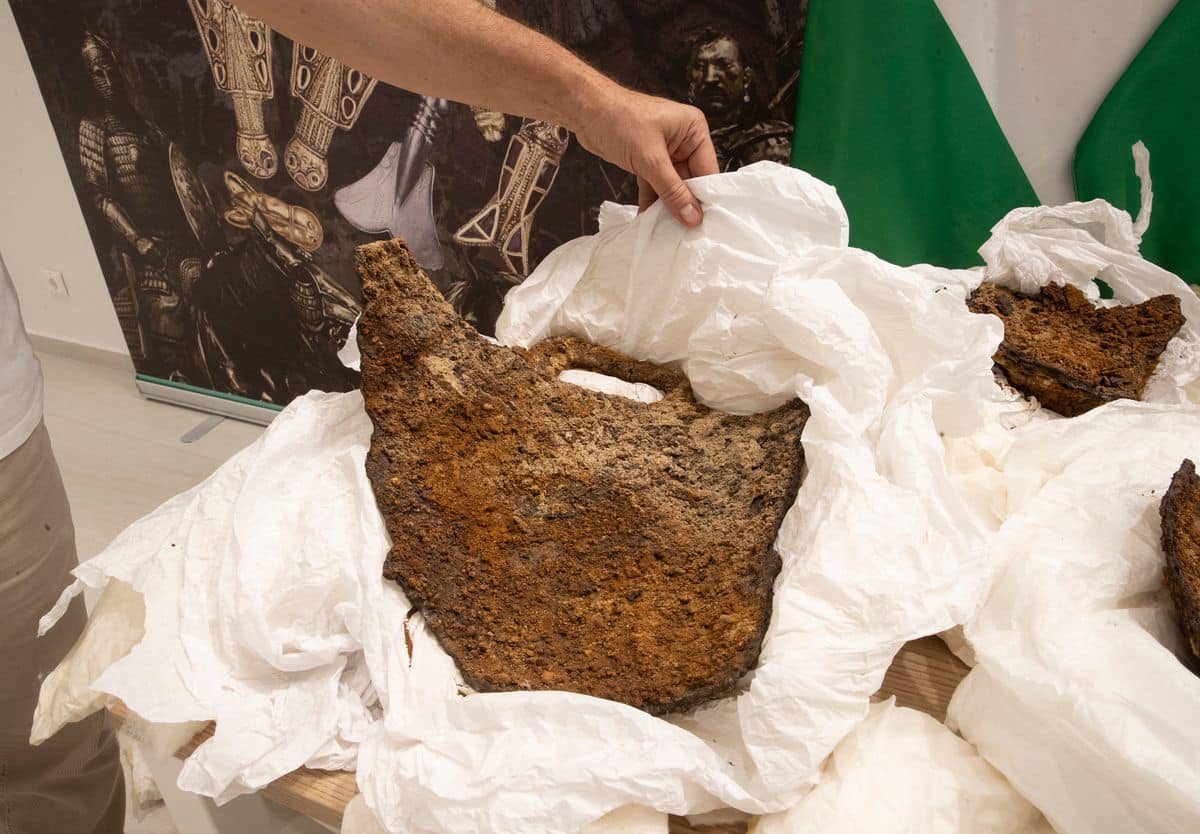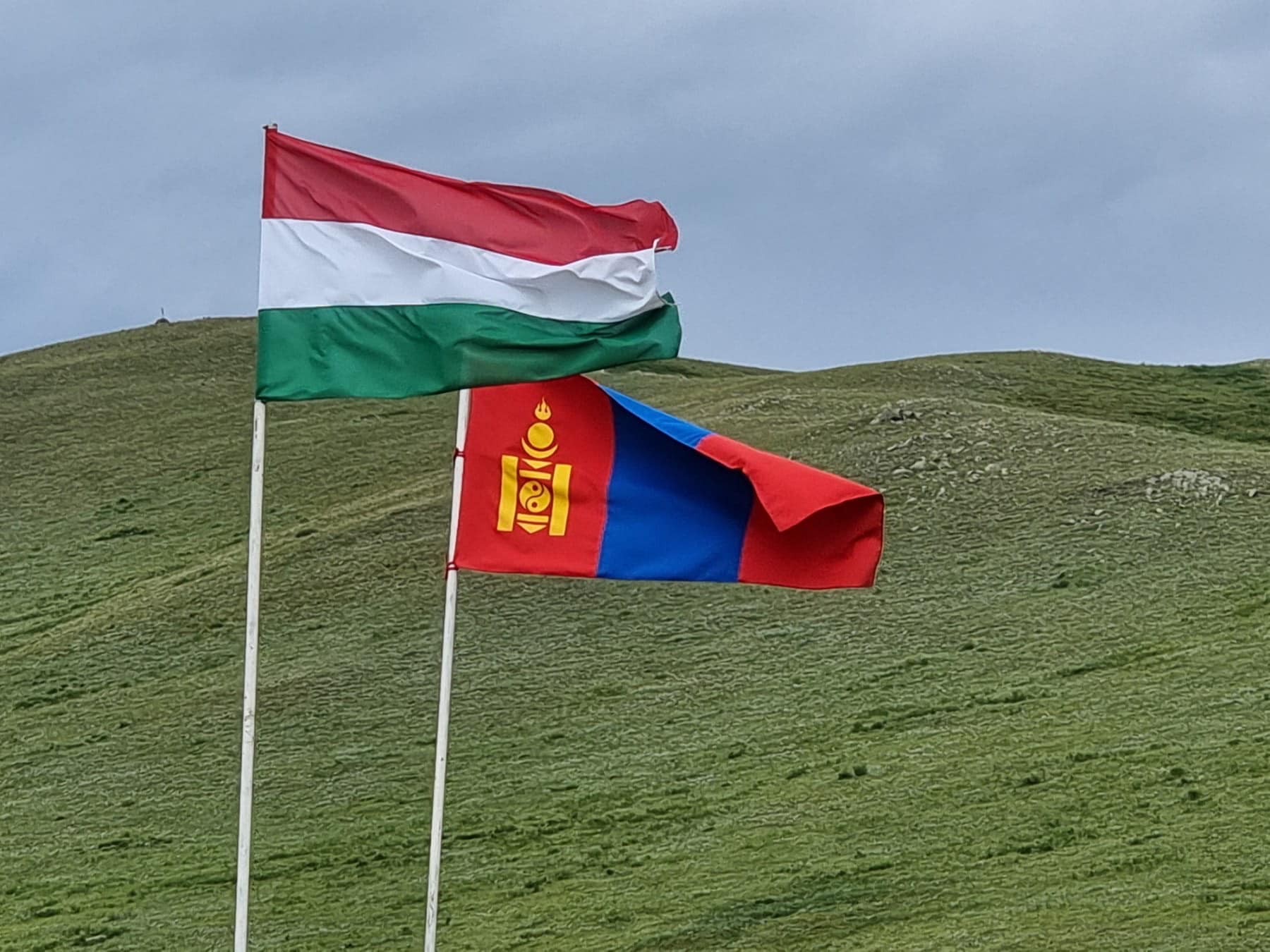Sensational find arriving in Hungary
"... Eurasian civilisations adopted these techniques from the steppe peoples, the Scythians and the Huns" - An ancient and unique Hun sacrificial cauldron has been excavated by Hungarian and Mongolian archaeologists.
The Institute of Hungarian Research received a special delivery the other day. Borbála Obrusánszky, Ambassador of Hungary to Ulaanbaatar brought two huge parcels from Mongolia, and at first glance, the two boxes contained rusty, solid, curved pieces of iron. But these simple, old, heavy pieces of metal are actually a real sensation. We interviewed the Ambassador and Gábor Horváth-Lugossy, Director General of the Institute of Hungarian Research about the content of the parcels.
András Rácz / Magyar Nemzet
- How does a thousand-year-old object come to the attention of Hungarian diplomacy?
- Cultural cooperation is a very important area of international relations, said the ambassador, who is herself a historian and an Orientalist (Mongolian) researcher of the steppe peoples, in particular the Huns.
- In this case, again, we had the opportunity to contribute to the achievements of Mongolian archaeology through a major scientific collaboration. The Institute of Hungarian Research and the Institute of Archaeology of the Mongolian Academy of Sciences signed an agreement back in 2021, as a result of which the excavation of a cemetery with around forty graves in Ar Gunt began this year. So far, seven tombs have been excavated and a rich artefactual material has been found. Among other things,
THE SACRIFICIAL CAULDRON, WHICH IS UNIQUE BECAUSE NO OTHER CAST-IRON CAULDRON OF THIS AGE AND SIZE HAS BEEN FOUND SO FAR ANYWHERE IN THE WORLD.

- And why did you bring this extraordinary find to Budapest?
- It was already clear during the excavations that it would be impossible to restore such a large object in Mongolia. However, the cooperation makes it possible to carry out the necessary conservation and reconstruction work in Hungary.
THE INSTITUTE OF HUNGARIAN RESEARCH HAS THE TECHNICAL AND PROFESSIONAL CAPACITY to accomplish the restoration; the find has arrived here, and I believe that the activity will start soon.
- Did you have the opportunity to follow the excavation of the cemetery?
- I was there when this cauldron was discovered. It was a fascinating experience to watch the archaeologists painstakingly unearth the graves. The Mongolian archaeologists allowed us to view the excavations. A Mongolian delegation, led by the Mongolian Deputy Minister of Culture M. Batbajar, was also interested in the works there. This cooperation is one of the major projects of the bilateral relations.
- On such visits, do archaeologists know that some valuable finds are to be expected? - I ask Gábor Horváth-Lugossy, Director General of the Institute.
- When an excavation area is designated, there's no way of knowing what the burial sites are hiding. But usually the chances of finding such a wonderful find are slim. Indeed, after the fall of the Hun Empire, the Chinese emperors supported and sometimes even financed the looting of Hun graves. On the one hand, they were after the gold and treasures, and on the other, they were seeking to eliminate sacred sites that had played an important role in the identity of the people living there. The imprint of this today is that almost all the Hun tombs are in a plundered state. That is why we had great luck with the excavation of the Asian Hun cemetery at Ar Gunti. Here we found unmolested graves, and in one of them the amazing artefact we have just unpacked.
- Let me add," the Ambassador resumes, "that these graves are easy to find and rob because the tombs are still visible on the surface, in the form of stone and earth piles that have been standing for thousands, sometimes two thousand years.
- Such burials were very common among the steppe peoples. From the Scythians to the Cumans it was customary that the more important the ruler, the more soil was brought to the tomb from distant parts of the empire, and the higher the mound was under which the ruler could rest in eternal sleep. We have such tombs in the area of Százhalombatta, for example. That’s why the name of the town translates into English as 'hundred mounds'," explained the Director-General.
- The uniqueness of the newly excavated cauldron has been mentioned several times. What is unique about it?
- IT IS NOT AN EXAGGERATION TO SAY THAT IT IS A SENSATIONAL FIND, BECAUSE A CAST IRON SACRIFICIAL CAULDRON OF THIS AGE AND SIZE HAS NEVER BEEN FOUND ANYWHERE ELSE IN THE WORLD.
When assembled, the cauldron is of about thirty litres. This is important because, although there are older bronze cauldrons, the production and casting of bronze objects did not even come close to the technical requirements of iron casting. While bronze requires 1000-1400 °C to be cast, iron castings require 1800 °C to be produced and held for at least 4-5 hours. After all, iron has a melting point of 1600 degrees Celsius, but here liquid iron was needed, and of course a crucible that could withstand this heat. So, our ancestors 2000-2500 years ago - which is about the time this cauldron dates back to - had such unparalleled technology and exceptional knowledge.

- Could such castings be made in China or Europe at that time?
- No, at that time there was no place where they could do that. This is the first object of its kind in the world. These techniques seem to have been adopted by Eurasian civilisations from the Steppe peoples, the Scythians and the Huns.
- Is it possible that an archetype of the Hun sacrificial cauldrons has been found?
- This is the oldest cast iron cauldron of this size we know of. There are only two cauldrons comparable to this one in Mongolia, which covers an area of one and a half million square kilometres and contains 13,000 Hun tombs. But they are much smaller. They don't even come close to the current find.
- The concept of the Hun sacrificial cauldron is well known among people interested in history. But do we know how it was used?
- They probably made some kind of concoction in it, which they all drank or ate. Goats or horses were sacrificed, probably cooked and eaten at ritual feasts. Herodotus writes of the Scythians that they would make a blood covenant and 'cutting their bodies would pour their blood into a vessel full of wine'. They may have used this cauldron in this way. It may also have played a role in the death rite, since here - and elsewhere, of course - it was buried with the dead leader.
- Was it used all over the Hun settlement area?
- Yes. Such a cauldron was also found in Hungary. The bronze cauldron of Törtel is a very beautiful and characteristic find, and it is the largest Hun bronze cauldron in the world.
- How many of these objects are kept in Eurasian museums?
- The number of Hun cauldrons may be between fifty and a hundred. However, it should also be noted that only one per cent of the artefacts survive, or are unearthed in excavations. Ninety-nine per cent have rotted, decayed, perished or have not yet been excavated. However whatever number we find, about 100 times as many were in use in their own time. So there must be quite a few still resting in the ground. Of the 13,000 Hun graves in Mongolia, only 220-250 have been excavated. Of course, the archeologists were almost always outpaced by grave robbers. Many more of these objects may have been buried with the dead, but precious metals were in great demand already in ancient times.
- So this cemetery, which for some reason has been missed by grave robbers, is very special.
- Yes, this is also a sensation. I don't even know if an undisturbed grave has ever been found in Mongolia. Let me add, this research is also sensational because there is no fully excavated Hun cemetery in Mongolia, this will be the first. This is important because we will excavate all the graves there and subject the finds to archaeogenetic analysis.
THE KIND OF COMPREHENSIVE RESEARCH NOW BEING CARRIED OUT BY THE INSTITUTE OF HUNGARIAN RESEARCH IN COLLABORATION WITH THE MONGOLIAN ACADEMY OF SCIENCES HAS NEVER BEEN DONE ANYWHERE IN THE WORLD.
Never before has it been possible to examine the material of an entire Hun cemetery. It remains to be seen who the tombs hide. Perhaps a Hun royal family used it as a burial place for centuries? If so, we have found the burial place of one of the oldest Hun dynasties. But it could also have been a sacred place where unrelated Hun rulers and chieftains were buried. In this case, we have found the most ancient sacred cemetery. Both will be unique scientific landmarks, and we will bring the latest research findings and conclusions first-hand to researchers around the world.
THANKS TO ARCHAEOGENETICS, WE CAN EXPAND OUR KNOWLEDGE ABOUT OUR ANCESTORS BY ANOTHER MILLENNIUM.
We are working to ensure that these exact results - which strengthen Hungarian identity and give reason for pride - become known to the Hungarian public as soon as possible.
- What will happen to the cauldron?
- Naturally, the cauldron will go back to Mongolia to the Genghis Khan Museum. Before that, of course, it will also be on display at our Institute. It will probably be part of a small chamber exhibition here AT THE INSTITUTE OF HUNGARIAN RESEARCH for a few months.
We have an agreement to bring a Mongolian exhibition of the most recently discovered Hun artefacts to Budapest. It is a very beautiful collection of objects: gilded and silver-plated horse harnesses and coffin mounts. The special cast-iron cauldron will of course be on display among them. I think that anyone who views this collection will immediately identify with most of the objects exhibited, and will find the shapes and ornaments familiar. Somehow these motifs are ingrained in us; they have an effect on us. We come from this same cultural background, which is why this excavation is so important for us.
Cover photo: Gábor Horváth-Lugossy and Borbála Obrusánszky (Photo: Miklós Teknős)
You may also be interested in:
Great interest in Hungarian prehistory and research on the East